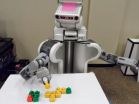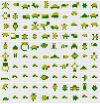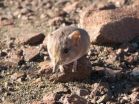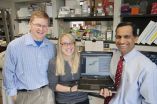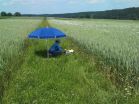(Press-News.org) University of Washington computer scientists have shown that crowdsourcing can be a quick and effective way to teach a robot how to complete tasks. Instead of learning from just one human, robots could one day query the larger online community, asking for instructions or input on the best way to set the table or water the garden.
The research team presented its results at the 2014 Institute of Electrical and Electronics Engineers International Conference on Robotics and Automation in Hong Kong in early June.
"We're trying to create a method for a robot to seek help from the whole world when it's puzzled by something," said Rajesh Rao, an associate professor of computer science and engineering and director of the Center for Sensorimotor Neural Engineering at the UW. "This is a way to go beyond just one-on-one interaction between a human and a robot by also learning from other humans around the world."
Learning by imitating a human is a proven approach to teach a robot to perform tasks, but it can take a lot of time. Imagine having to teach a robot how to load the dishwasher – it might take many repetitious lessons for the robot to learn how to hold different types of cookware and cutlery and how to most efficiently fill the machine.
But if the robot could learn a task's basic steps, then ask the online community for additional input, it could collect more data on how to complete this task efficiently and correctly.
"Because our robots use machine-learning techniques, they require a lot of data to build accurate models of the task. The more data they have, the better model they can build. Our solution is to get that data from crowdsourcing," said Maya Cakmak, a UW assistant professor of computer science and engineering.
The research team, led by professors Rao and Cakmak, also includes UW computer science and engineering graduate student Michael Jae-Yoon Chung and undergraduate Maxwell Forbes. The team designed a study that taps into the online crowdsourcing community to teach a robot a model-building task. To begin, study participants built a simple model – a car, tree, turtle and snake, among others – out of colored Lego blocks. Then, they asked the robot to build a similar object. But based on the few examples provided by the participants, the robot was unable to build complete models.
To gather more input about building the objects, the robots turned to the crowd. They hired people on Amazon Mechanical Turk, a crowdsourcing site, to build similar models of a car, tree, turtle, snake and others. From more than 100 crowd-generated models of each shape, the robot searched for the best models to build based on difficulty to construct, similarity to the original and the online community's ratings of the models.
The robot then built the best models of each participant's shape.
This type of learning is called "goal-based imitation," and it leverages the growing ability of robots to infer what their human operators want, relying on the robot to come up with the best possible way of achieving the goal when considering factors such as time and difficulty. For example, a robot might "watch" a human building a turtle model, infer the important qualities to carry over, then build a model that resembles the original, but is perhaps simpler so it's easier for the robot to construct.
"The end result is still a turtle, but it's something that is manageable for the robot and similar enough to the original model, so it achieves the same goal," Cakmak explained.
Study participants generally preferred crowdsourced versions that looked the most like their original designs. In general, the robot's final models were simpler than the starting designs – and it was able to successfully build these models, which wasn't always the case when starting with the study participants' initial designs.
The team applied the same idea to learning manipulation actions on a two-armed robot. This time, users physically demonstrated new actions to the robot. Then, the robot imagined new scenarios in which it did not know how to perform those actions. Using abstract, interactive visualizations of the action, it asked the crowd to provide new ways of performing actions in those new scenarios. This work will be presented at the Conference on Human Computation and Crowdsourcing in November.
Other research teams at Brown University, Worcester Polytechnic Institute and Cornell University are working on similar ideas for developing robots that have the ability to learn new capabilities through crowdsourcing.
The UW team is now looking at using crowdsourcing and community-sourcing to teach robots more complex tasks such as finding and fetching items in a multi-floor building. The researchers envision a future in which our personal robots will engage increasingly with humans online, learning new skills and tasks to better assist us in everyday life.
INFORMATION:
This research was funded by the U.S. Office of Naval Research and the National Science Foundation.
Posted with photos, video: http://www.washington.edu/news/2014/06/26/ask-the-crowd-robots-learn-faster-better-with-online-helpers/
For more information, contact Cakmak at mcakmak@cs.washington.edu or 206-685-5643 and Rao at rao@cs.washington.edu or 206-914-4719.
More project videos: http://bit.ly/1nHSxzF
Ask the crowd: Robots learn faster, better with online helpers
2014-06-26
ELSE PRESS RELEASES FROM THIS DATE:
New species of small mammal discovered by scientists from California Academy of Sciences
2014-06-26
SAN FRANCISCO (June 26, 2014) – Scientists from the California Academy of Sciences have discovered a new species of round-eared sengi, or elephant-shrew, in the remote deserts of southwestern Africa. This is the third new species of sengi to be discovered in the wild in the past decade. It is also the smallest known member of the 19 sengis in the order Macroscelidea. The team's discovery and description of the Etendeka round-eared sengi (Macroscelides micus) is published this week in the Journal of Mammalogy.
While collecting and examining sengi specimens from southwestern ...
Miriam Hospital researchers develop app focused on making obese adults less sedentary
2014-06-26
PROVIDENCE, R.I. – Even individuals who exercise a lot can be at risk for health problems if they also spend a lot of time in sedentary behaviors, such as sitting. More sedentary time, regardless of physical activity levels, is associated with greater risk for obesity, cardiovascular disease and mortality. However, a smartphone-based intervention developed by researchers at The Miriam Hospital can produce short-term reductions in sedentary behavior that may be effective in improving health. The findings of a study that utilized this app are published in PLOS ONE, a peer-reviewed ...
You can't teach speed: Sprinters break 10-year rule
2014-06-26
ALLENDALE, Mich. — New research shows world-class sprinters are born, not created. Grand Valley State University researchers found that exceptional speed prior to formal training is a prerequisite for becoming a world-class sprinter. The findings are published in the online journal PeerJ, https://peerj.com/articles/445/.
The research, conducted by Michael Lombardo, professor of biology, and Robert Deaner, associate professor of psychology, shows that the developmental histories of elite sprinters contradict the popular deliberate practice model of expertise. According ...
The social psychology of nerve cells
2014-06-26
The functional organization of the central nervous system depends upon a precise architecture and connectivity of distinct types of neurons. Multiple cell types are present within any brain structure, but the rules governing their positioning, and the molecular mechanisms mediating those rules, have been relatively unexplored.
A new study by UC Santa Barbara researchers demonstrates that a particular neuron, the cholinergic amacrine cell, creates a "personal space" in much the same way that people distance themselves from one another in an elevator. In addition, the study, ...
US should re-evaluate definition of skilled workers in immigration policy
2014-06-26
New immigration research from Rice University, the University of North Carolina and the Centre for Population, Poverty and Public Policy Studies suggests the U.S. should re-evaluate its definition of skilled workers to include informal skills of migrant workers.
The study, "Identifying and Measuring the Lifelong Human Capital of 'Unskilled' Migrants in the Mexico-U.S. Migrator Circuit," draws on a binational multistage research project that involved interviews with 320 Mexican migrants and return migrants in North Carolina and Guanajuato, Mexico. The study identifies ...
Researchers home in on way to predict aggressiveness of oral cancer
2014-06-26
Studying mouth cancer in mice, researchers have found a way to predict the aggressiveness of similar tumors in people, an early step toward a diagnostic test that could guide treatment, according to researchers at Washington University School of Medicine in St. Louis.
"All patients with advanced head and neck cancer get similar treatments," said Ravindra Uppaluri, MD, PhD, associate professor of otolaryngology. "We have patients who do well on standard combinations of surgery, radiation and chemotherapy, and patients who don't do so well. We're interested in finding out ...
Over-activity of enzyme HDAC6 exacerbates symptoms of Amyotrophic Lateral Sclerosis
2014-06-26
Scientists at VIB and KU Leuven have demonstrated in fruit-flies that over-activity of the enzyme HDAC6 in the nerve ends exacerbates the symptoms of the neurodegenerative condition Amyotrophic Lateral Sclerosis (ALS / Lou Gehrig's Disease). Inhibition of this enzyme could offer a protective effect against ALS.
Patrik Verstreken (VIB/KU Leuven): "Nobody wants to suffer from a degenerative condition such as amyotrophic lateral sclerosis (ALS), in which you lose coordination of all muscles through gradual damage to the nerve cells. ALS patients are conscious throughout ...
Organic agriculture boosts biodiversity on farmlands
2014-06-26
Organic farming fosters biodiversity. At least that's the theory. In practice, however, the number of habitats on the land plays an important role alongside the type and intensity of farming practices. These are the findings of an international study that looked at 10 regions in Europe and two in Africa. The results has been published in Nature Communications. The study shows that even organic farms have to actively support biodiversity by, for example, conserving different habitats on their holdings.
An international team, including participants from Technische Universität ...
We speak as we feel -- we feel as we speak
2014-06-26
A team of researchers headed by the Erfurt-based psychologist Prof. Ralf Rummer and the Cologne-based phoneticist Prof. Martine Grice has carried out some ground-breaking experiments to uncover the links between language and emotions. They were able to demonstrate that the articulation of vowels systematically influences our feelings and vice versa.
The research project looked at the question of whether and to what extent the meaning of words is linked to their sound. The specific focus of the project was on two special cases; the sound of the long 'i' vowel (/i:/) and ...
Rosin up that bow, maestro. And thank your genes
2014-06-26
EAST LANSING, Mich. --- Mom or dad may have driven you to cello rehearsal all those years, but you can also thank your genes for pushing you to practice, according to new research led by a Michigan State University professor.
Genetics and environment work together to help people become accomplished musicians, finds the study of 850 sets of twins. It's another arrow in the quiver of the argument that both nature and nurture play a role in developing expertise.
"The nature vs. nurture debate has raged since the beginning of psychology," said Zach Hambrick, MSU professor ...
